Custom charts for Jira are not just fancy graphics; they serve a crucial role in project management and resource planning. They provide a visual representation of complex data, making it easier for stakeholders to grasp the project's progress, bottlenecks, and overall health. Customizing your Jira reports and dashboards can completely change how you handle projects:
- Improve project tracking with tailored visual data representations.
- Make informed decisions with accurate, real-time data.
- Share insights effortlessly with internal and external stakeholders.
By leveraging custom charts, you can ensure your project management process is as efficient, transparent, and responsive as possible.
What Is Custom Charts for Jira?
Custom charts for Jira are a variety of visual representations, such as pie charts, bar charts, line charts, and more, to suit different analytical needs. These comprehensive charts can be embedded within Jira dashboards, reports, or even within Confluence, offering a centralized view of crucial metrics accessible to all stakeholders.
Custom charts are highly interactive: users can drill down into specific data points, filter results, and even automate their updates based on real-time data changes. This level of customization and interactivity makes it easier for teams to identify trends, track key performance indicators (KPIs), and adapt strategies on the fly.
Third-party apps like ActivityTimeline extend the capabilities of custom Jira charts and Jira dashboard by offering an opportunity to build charts that aren't available out-of-the-box, such as the chart of capacity and planned vs. actual comparisons. With these tools, you can monitor your team's workload, anticipate future resource needs, and ensure that your project stays on track.
Why Use Custom Charts for Jira?
Custom charts are essential tools for project managers who want better control and decision-making power. Give your Jira data more than just a basic look at metrics as they make the data come alive, enabling you to easily spot trends, bottlenecks, and areas where the team is doing well or needs improvement.
One big benefit of custom charts is their flexibility. Whether you’re creating a chart of capacity to manage workloads or a sprint report to measure your team’s efficiency, the customization options ensure the reports fit your specific needs.
Furthermore, custom charts for Jira reports and Jira Dashboard make it easy to share insights beyond your immediate team. You can embed custom Jira charts for Confluence pages to share updates and progress with stakeholders, ensuring everyone is on the same page.
These charts do more than track and visualize data; they are also important for predicting future trends. By comparing past data with current project metrics, project managers can address potential issues before they become real problems.
Where to Find and Customize Jira Charts
First, it's essential to recognize the tools available at your disposal in the Jira service management portal. Creating custom charts involves understanding the various types of charts and how to personalize them to meet your specific needs. Here's a step-by-step guide:
Jira Reports and Charts

You can find some predefined charts in the “Reports” section:
- Burndown Chart: Track the completion of work over time. Ideal for teams following Scrum or other agile methodologies.
- Velocity Chart: Shows sprint progress and the amount of work completed, helping teams understand their performance over time.
- Pie Chart: Provides a visual breakdown of issues based on specific criteria, such as status or priority.
Adding Charts on Jira Dashboards
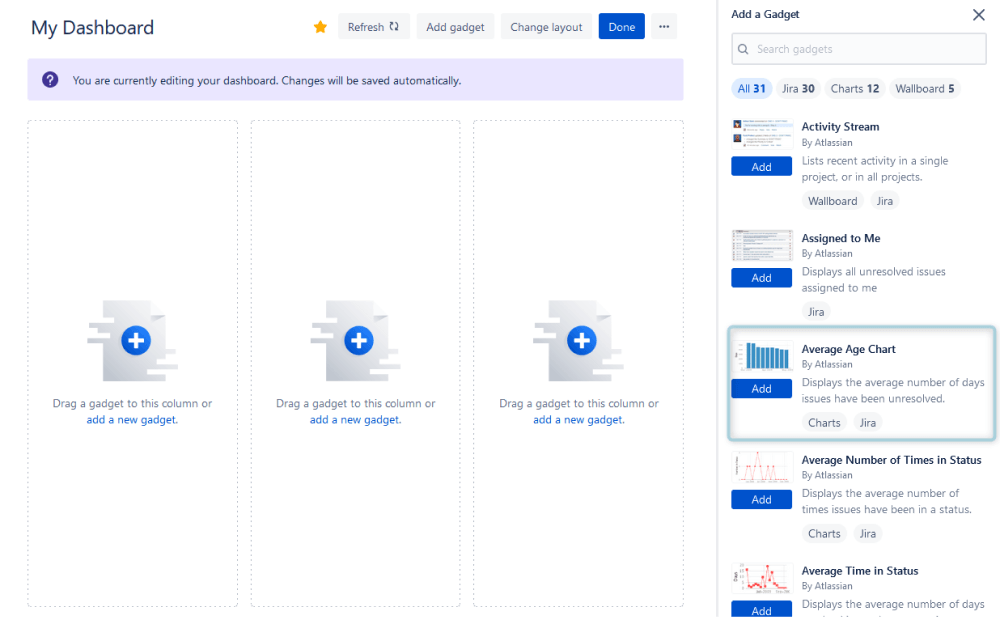
Advanced users can create an entire Jira Dashboard and add various reports, charts, and graphs:
- Custom Graphs: Tailored visual representations using different chart types, such as bar charts, pie charts, line charts, etc.
- Filter Results: Use Jira Query Language (JQL) to filter data, providing specific insights directly relevant to your project’s needs.
- Gadgets: Use a variety of gadgets available in Jira to add to your dashboard, presenting data dynamically.
Integrating specialized tools from the Atlassian Marketplace can greatly enhance your charting capabilities. The ActivityTimeline app offers features for resource planning and tracking, providing multiple reports and charts for a better monitoring experience. This includes the ability to build dashboards for team capacity, project workload, and more.
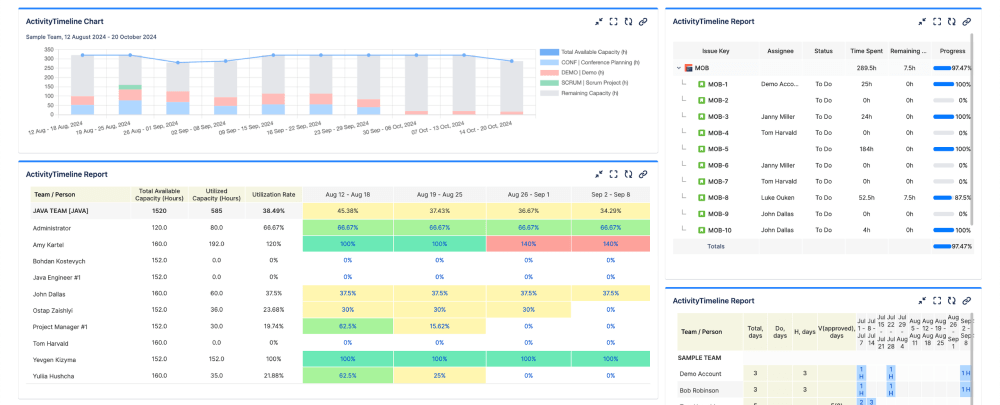
Customizing Charts with Add-ons
For users needing advanced customization, add-ons can be invaluable. Add-ons like ActivityTimeline let you customize your Jira sprint reports and other necessary metrics. They help you generate bespoke charts like the chart of capacity, tailored to your requirements.
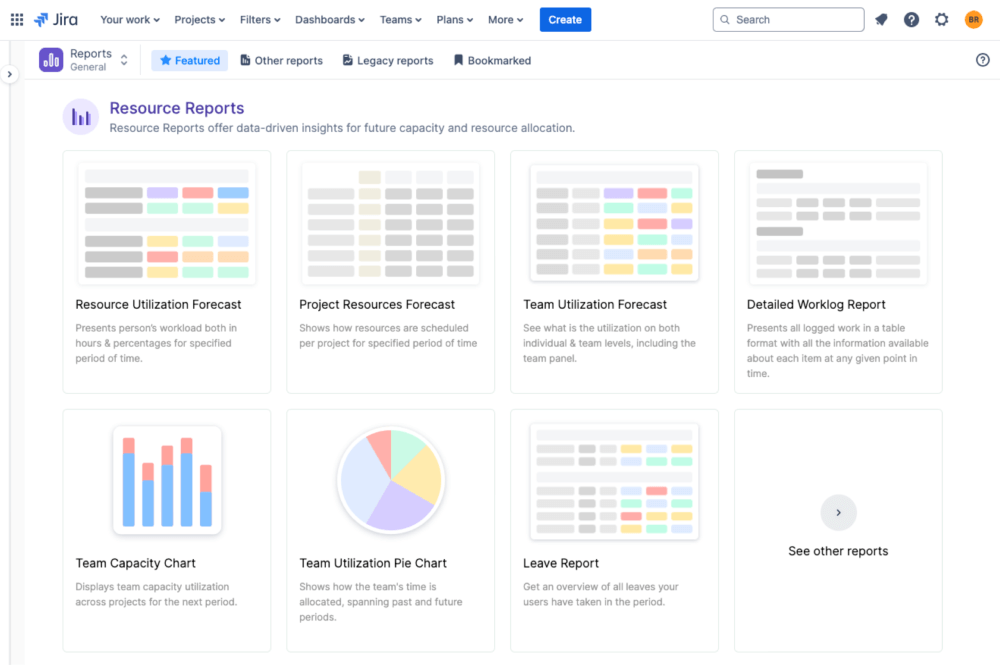
You can both find resource and project reports and charts there.
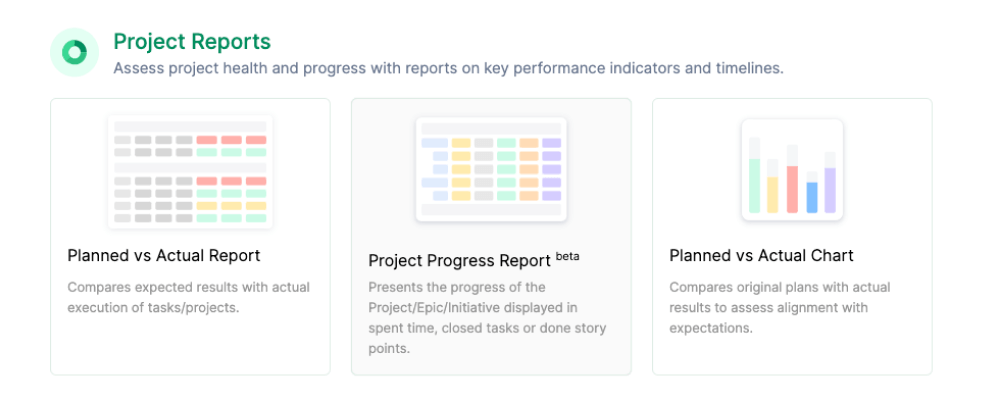
Here’s how you can get started:
- Step 1: Install the add-on from the Atlassian Marketplace.
- Step 2: Navigate to the add-on’s dashboard within Jira.
- Step 3: Choose the type of custom chart you need. Options typically include bar charts, pie charts, and more.
- Step 4: Customize the data sources, custom fields, and filters to match your project's parameters.
These steps provide a structured way to create a custom chart, ensuring that your data visualization aligns perfectly with your project's demands. By leveraging ActivityTimeline, you can build insightful and visually appealing charts for Jira instance reporting that cater to your unique project needs.
Visualizing Jira Data with Team Capacity Chart
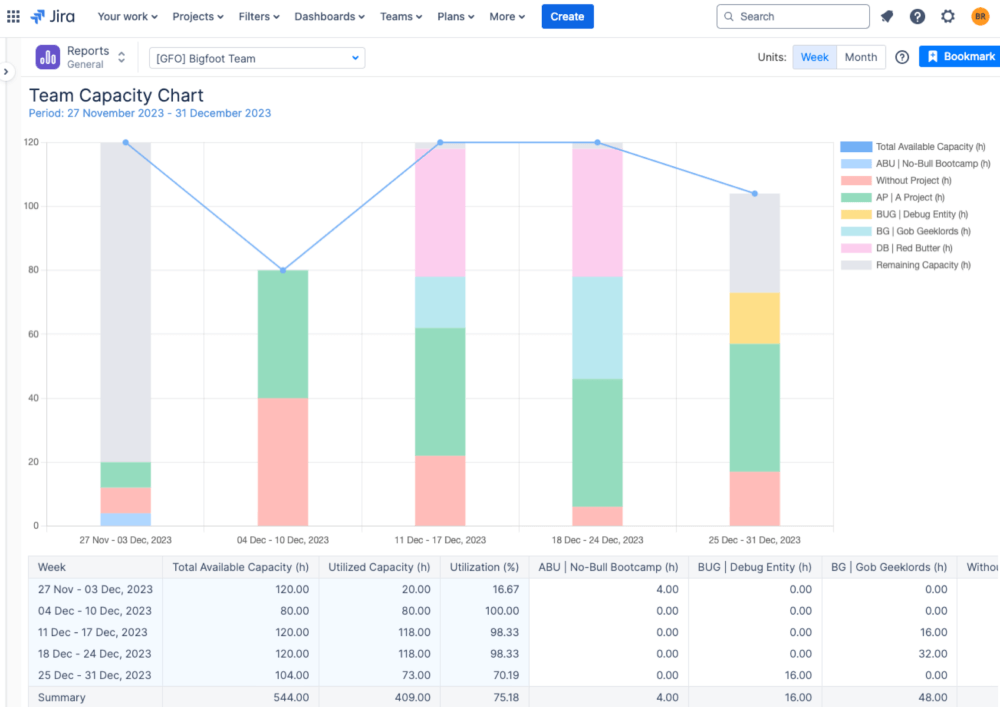
With beautiful reports on the team's capacity, you can easily spot any issues or areas where the workload is uneven. For instance, if you find that a large part of your team's capacity is still free, you can reassign tasks to optimize performance.
Using the Team Capacity Chart in ActivityTimeline is simple and offers various options to fit your needs. Its main components include:
- Available Capacity: The total time team members can work, accounting for things like vacations and days off.
- Utilized Capacity: The workload already assigned to team members, calculated from Jira tasks, bookings, placeholders, and calendar events.
- Remaining Capacity: The difference between the total available capacity and the used capacity.
- Utilization: Shown as a percentage, this indicates how much of the team's capacity is scheduled for use.
Start by selecting the team you want to analyze. The chart focuses on one team at a time for detailed insights. Choose the time period you want to look at. You can pick from default timeframes or set a custom one. This helps ensure that the data matches your planning and reporting needs.
Select the projects and time units (weeks or months) to include in your chart. This helps narrow down the data for a clear view of your team's capacity. You can also apply Jira Filters to include or exclude specific issues, bookings, or placeholders:
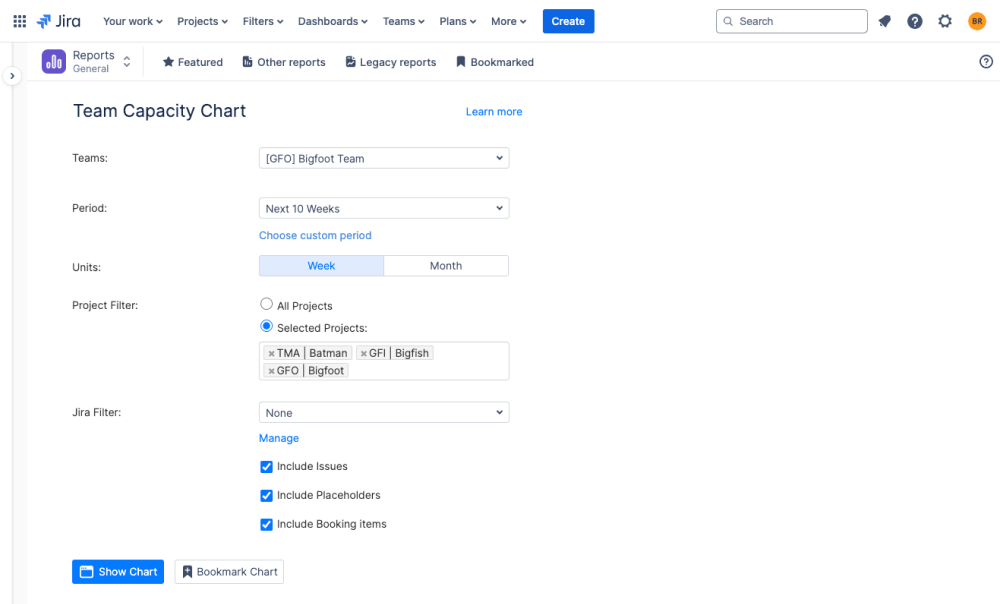
The chart includes all items with estimates by default, but you can exclude some if needed. This customization ensures that your report focuses on the most important data, making your analysis more accurate and actionable.
Planned vs. Actual Chart for Jira
Among other chart templates, this one helps highlight the differences between planned work and actual work done. By comparing scheduled and logged time, the Planned vs. Actual Chart helps teams see where they might be under or overestimating their resources and effort.

For example, if a large portion of scheduled tasks shows less logged time, it indicates underutilization or potential bottlenecks. If logged time far exceeds scheduled time, it may suggest scope creep or unplanned tasks affecting the schedule, which needs immediate attention.
To make the most out of this chart, follow these steps:
- Configure the Chart: Choose the specific team, project, or epic you want to report on, along with the period. Customization options ensure relevance.
- Analyze the Data: Examine how closely actual logged time matches the scheduled time. Look for patterns and any underestimations or overestimations.
- Adjust Plans Accordingly: Use these insights to refine your project plans. Adjust future task estimates, redistribute the workload, and update team availability.
The Planned vs. Actual Chart serves as a feedback tool and a proactive planning aid, enabling continuous improvement in your project management practices.
Team Utilization Pie Chart
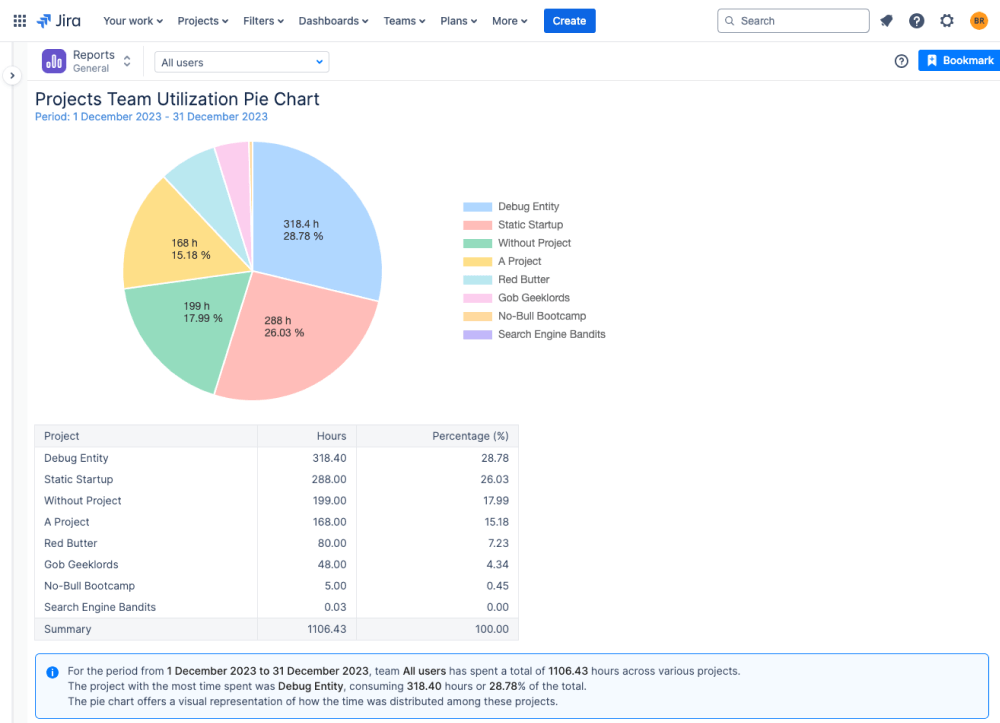
With the Team Utilization Pie Chart, you can easily see how your team's time is distributed across different projects. This chart is perfect for project managers who need to understand how resources are being used and plan for the future.
By looking at past time allocation, you can see how your team used its resources, helping you make better decisions for the future. The future time allocation view lets you predict upcoming workloads, making sure no one is overworked or underutilized.
This chart is also a great tool for communicating with stakeholders. It provides a clear visual breakdown of time usage, making it easier to discuss project progress and planning.
The chart offers two main views:
- Past Time Allocation: Uses data from logged work hours, bookings, and calendar events to show how the team's time was spent in the past.
- Future Time Allocation: Uses estimates, bookings, placeholders, and upcoming calendar events to predict future time allocation.

You can configure this chart in several ways:
- Reporting Scope: Choose between using Worklogs (Past) or Estimates (Future).
- Team Selection: Pick the team you want to analyze.
- Period: Adjust between predefined or custom time periods.
- Detailed By: Break down data by Jira Project or Epic.
Using detailed insights from this chart, you can manage team capacities, foresee bottlenecks, and ensure smooth project flow.
Summary
As you explore custom charts for Jira, you can see how these visualization tools can boost your project management. Using charts for capacity planning, comparing planned vs. actual efforts, and checking team utilization provide key insights into team performance and project progress.
Whether you use the Jira dashboard's built-in Reports section, customize dashboards with different charts, or use add-ons like ActivityTimeline, you have many options to turn data into useful insights. By tailoring your charts to fit your projects, you can make better decisions and manage resources more effectively, leading to project success.











.png)






